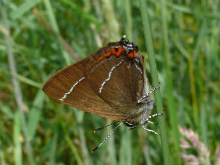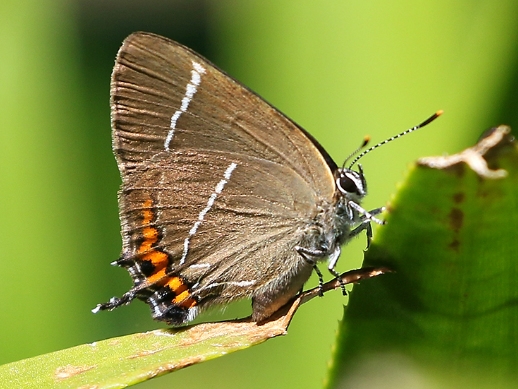
| Butterfly Conservation |
 |
| Hertfordshire & Middlesex Branch |
 |
|
|||
| Saving butterflies, moths and our environment | ||||


White-letter HairstreakSatyrium w-albumLocally common Distribution and Status The White-letter Hairstreak is fairly widespread and common around elms in our branch area. During the 1970s Dutch Elm Disease had a devastating effect on elm which is the butterfly's larval foodplant but the butterfly can breed on regenerating young suckers at least until they reach a certain height. Disease-resistant elms are now being planted to ensure populations are maintained. Because of its elusive behaviour by mostly sitting around on the tree canopy, it is under-recorded so it is likely that more colonies are yet to be discovered. Mainly due to the research and efforts by Andrew Middleton and Liz Goodyear many new colonies were found in the two counties which is encouraging Habitat Requirements Hedgerows, edges of woodland and isolated clusters of elms even in urban areas. The same breeding sites tend to be used every year Larval Foodplants Wych Elm Ulmus glabra, English Elm Ulmus procera, Small-leaved Elm Ulmus minor. One disease-resistant form of elm is Dutch Elm also known as 'Sapporo Autumn Gold' Ulmus japonica Adult Food Sources Bramble Rubus fruticosus agg., Creeping Thistle Cirsium arvense, Honeydew, Wild Privet Ligustrum vulgare Behaviour/Observation notes Like most of the other hairstreaks this species is not easy to find as it spends much of its time flitting over the tops of elm trees. Probably the best time of day to find it is in the early morning, say 09:00 hours, for males which actively defend their territories in the canopy. Any brown 'speck' jinxing about may well be a White-letter Hairstreak. Both sexes do occasionally descend to lower levels to feed on nectar but their wings are always closed when resting or feeding. The butterfly overwinters as an egg and searching for the eggs is a good way to find colonies. Finding flowery elms in the winter and early spring should be easy to locate with their pink or white blossoms Life History This species produces only one generation a year with adults emerging from the end of June into July and the odd specimen lingering on into August. Females lay eggs singly, usually on a scar between old and new growth and spends the winter in this stage. In the spring, larvae emerge to feed firstly on the buds then on the leaves. In June, a pupa is formed attached to a twig or stem Further information
White-letter Hairstreak Recording Project |
Copyright Butterfly Conservation © 2019 Hertfordshire & Middlesex Branch
Privacy and Copyright Statement and Cookie Policy Statement
Butterfly Conservation
Company limited by guarantee, registered in England (2206468)
Registered Office: Manor Yard, East Lulworth, Wareham, Dorset, BH20 5QP. Tel: 01929 400 209
Charity registered in England & Wales (254937) and in Scotland (SCO39268). VAT No. GB 991 2771 89